The airline industry is undergoing a seismic transformation as passengers reevaluate their preferences in the wake of the COVID-19 pandemic. The once-revered cheap seats are no longer sufficient for many travelers; they now seek more comfort and amenities, opting to spend extra for seats in the front of the cabin. This shift not only reshapes airline profitability but also alters competitive dynamics among frequent flyers. As we navigate this new era of air travel, it becomes clear that traditional loyalty programs are being redefined, reflecting the changing desires of modern consumers.
Post-pandemic travel patterns reveal that a significant segment of passengers is willing to pay premium prices for better seating options. Pre-flight surveys and airline data suggest that the appetite for first-class and premium economy seats has markedly increased, with airlines reporting higher fill rates in these sections. Delta Air Lines President Glen Hauenstein noted the unprecedented demand for premium tickets, even during off-peak seasons, an indicator that travelers are prioritizing comfort over cost.
The differences in pricing between economy and premium cabins are stark. For example, a round-trip ticket for standard economy can start as low as $347, while premium seats can reach upwards of $1,791, creating a significant revenue stream for airlines. Such disparities have implications for consumer behavior; many travelers view premium seating not just as a luxury, but as a necessary investment in their overall travel experience.
The landscape for frequent flyers is swiftly changing. Airlines have adapted their loyalty programs, focusing more on customer spending rather than simply the miles flown. In the past, the frequent flyer system incentivized travelers to accumulate miles through extensive travel. However, this model is now evolving, with significant spend thresholds required to gain elite status. Consequently, the pool of elite-status frequent flyers is expanding, increasing competition for premium seats.
This restructuring benefits airlines financially but creates a more competitive atmosphere. With heightened competition, airlines are faced with the challenge of balancing rewards for loyal customers while maximizing revenue from premium cabin sales. As reported, many airlines now derive much of their income from main cabin economy tickets, underscoring the need for strategic repositioning in their approaches to customer engagement and pricing.
As the allure of paid premium seating grows, the prevalence of free upgrades has sharply declined. Where once complimentary upgrades were seen as standard fare within loyalty programs, airlines are now focusing on monetizing premium cabin access. Hauenstein remarked on how only 12% of Delta’s first-class seats were sold 15 years ago, compared to nearly 75% today, illustrating a fundamental shift in how valuable airline seats are allocated.
This trend is not isolated to legacy carriers. With budget airlines like Frontier and JetBlue also introducing enhanced premium offerings, the notion of “cheap travel” is evolving. Passengers now have a broader range of choices as airlines innovate their service offerings to include more luxurious seating options, including lie-flat beds and enhanced amenities.
In response to persistent demand for premium seating, airlines are reconfiguring their fleets. Carriers are retrofitting existing aircraft to enhance cabin classes, introducing “junior” business class sections, and removing traditional first-class configurations entirely. American Airlines and Alaska Airlines are spearheading such alterations, designing aircraft interiors that emphasize a more expansive premium experience. This adaptation reflects a clear market demand – consumers are no longer satisfied with generic offerings and are willing to pay extra for a more tailored travel experience.
Airlines are now competing to provide the most appealing premium experiences, complete with state-of-the-art seating and onboard service. As Scott Chandler of American Airlines noted, there is growing customer interest in premium features, compelling airlines to provide novel post-purchase upgrade options to capitalize on this desire.
The evolving landscape of airline seating can also be attributed to shifting consumer demographics. Younger travelers are increasingly inclined to spend on high-quality travel experiences, demonstrating a willingness to prioritize their comfort over budget considerations. Southwest Airlines, for instance, is planning to introduce extra-legroom options and retire its longstanding open seating policy to cater to this emerging consumer base.
While some airlines remain cautious about introducing full premium cabins, their strategies are nonetheless indicative of changing market dynamics. The traditional notions of what constitutes air travel are altering, as consumer expectations and willingness to pay redefine service models in the aviation industry.
As we look forward to the future of air travel, it is evident that the demand for enhanced premium seating is reshaping the airline industry’s offerings and profitability. The combination of evolving consumer preferences, increased competition for elite status, and strategic innovations in aircraft configurations indicates a significant transformation in air travel norms. The industry stands at a crossroads, where airlines must strike a delicate balance between meeting customer desires for comfort and ensuring financial sustainability in an ever-changing market landscape.

